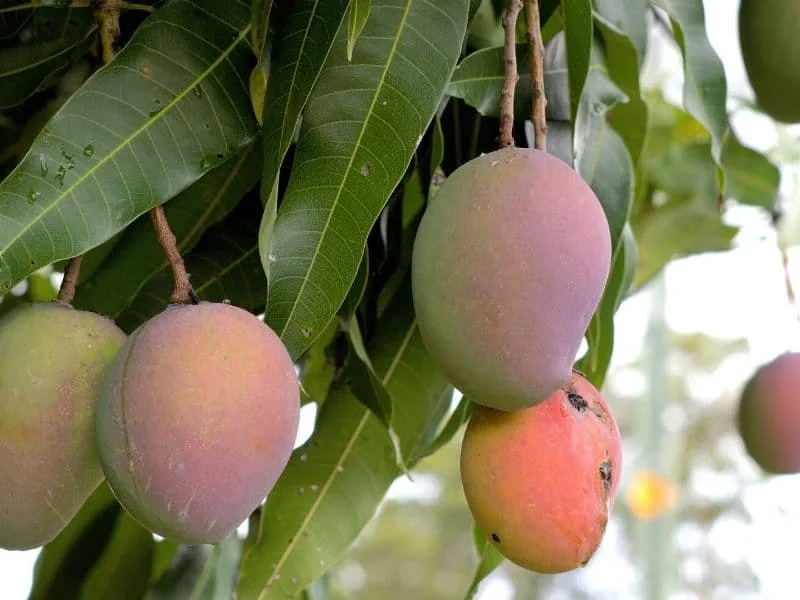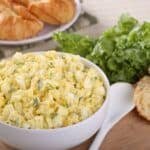Regarding mangoes, foodies are generally familiar with the popular Kensington Pride and Bowen varieties. But many fans might be surprised to learn that these two varieties of mango have a lot in common—so much so that they’re often confused for one another!
Keep reading to find out!
Are Kensington Pride and Bowen Mangoes the same? Yes, Kensington Pride is the same kind of mango as Bowen Mango.

Kensington Pride Mango: What Is It?
The Kensington Pride mango is Australia’s own best of the best. It is a named commercial mango cultivar that originated in Australia and accounted for over eighty percent of this country’s annual retail market. It is considered to have a distinctive flavor compared with other Florida-bred varieties grown elsewhere.
It is a super-sweet, juicy, and slightly tangy variety that grows in the Northern Territory. Many experts have called these Aussie mangoes one of the best in the world. The Kensington Pride was first bred at Queensland’s Horticulture Research Station as a cross between two varieties: Kent and Haden (the second most popular type of mango grown in Florida).
Kensington Pride is an Australian institution. And it’s no wonder why. Taste-wise, they’re like nothing else in the world.
Are Bowen Mangoes the Same as Kensington Pride?
Yes, Kensington Pride is the same mango as Bowen Mango. Sometimes, people use the term “KP,” Bowen, Bowen Special, or Bowen mango to refer to Kensington Pride Mango.
The name Kensington Pride and Bowen Mangoes go back to the history of the fruit.
The original tree emerged in Bowen, Queensland, in the late 1880s. It was given “Pride of Bowen” and “Bowen Special.”
Then, a local farmer, Mr. Harry Lott, isolated a good fibreless flesh mango among various mango seeds. He cultivated it on his farm, ‘Kensington,’ circa 1880, from whence it spread to other regions known as Kensington Pride.
Bowen Mango vs. Kensington Pride: The History

Mango tree. Credit: canva
The first tree was born in Bowen, Queensland, in the late 1880s and early 1890s (although the fruit wasn’t formally described until after 1960). It was likely imported from India by someone with a horse trading business.
The polyembryonic nature of the fruit suggests a southeast Asian origin, although its oval shape and color look very similar to Indian cultivars.
Kensington Pride Mangoes come from Australia. Passing the fruit’s seed to a Bowen Harbour and Customs Officer, GE Sandrock, in 1937 led to Mr. McDonald planting trees in his garden.
Within decades, the trees were planted throughout Bowen. In 1905, a local farmer named Mr. Harry Lot noticed the fruits’ popularity at the market and started growing his orchard on Adelaide Point. The resulting fruit was popular in the local markets, and he took it upon himself to name them after their original property: Kensington.
The Kensington Pride has been recognized for its superior taste around the world. The success of this popular variety is attributed to its polyembryonic nature. It is also credited with helping to put Bowen on the map as one of Australia’s most important commercial agricultural areas outside of Victoria and New South Wales.
Cultivation 101
What Is Cultivar
The word ‘cultivar’ refers to a cultivated variety that typically results from hybridization, which is exclusively human intervention. Often those cultivars occur in nature as mutations, but breeders create most; they are called hybrids.
There are many cultivars of crops. Tomatoes, apples, and watermelons have many cultivars. Seedless grapes and roses are also examples of crops with varieties. Ornamental plants like orchids and roses also have cultivated varieties.
What Is Polyembryonic?
The ‘poly’ in that word means it can reproduce itself without fertilization and, therefore, multiply fast and yield many fruits per tree. The ’embryo’ part of the name refers to how each fruit contains two or more seeds developing within one ovary wall.
The Kensington Pride mango is one of the poly-embryonic mango varieties. It is a self-fertilizing hybrid of two Indian varieties. The first parent tree was imported from India, likely in the late 1800s or early 1900s. It’s unknown where this fruit came from, but it has been verified that some trees were growing on Bowen Island by 1915 and have been traced back to before the 1900s.
Bowen Mangoes: What You Need to Know

Credit: canva
Health Benefits
It’s a healthy snack. They pack fiber, potassium, vitamin C, and other natural plant compounds that may help prevent heart disease.
What Does It Looks Like?
It is a medium-sized fruit, averaging about three to four inches in diameter. The skin color is bright yellow, and the ripe fruit has red and green patches over an orange background.
What Does The Texture Like?
The texture can range from being very firm at its peak ripeness (or soon after harvest) to being quite soft. The texture also changes as the fruit ripens and becomes softer with a higher juice content and juicy flavor at its peak flavor.
Bowen mangoes are often eaten fresh out of hand or sliced in half for serving over ice cream or sorbet. They’re delicious on their own, or in a salad, as an ice cream topping, or mixed into fruit and yogurt.
Their crispy texture makes them perfect for eating alone or in desserts like mango pie. This fruit is the way to go if you’re looking for a refreshing summer treat.
What Does the Mango Taste Like?
The Kensington Pride’s sweet-yet-tangy taste makes it unique and attractive to people worldwide. And that includes those Australian mango eaters. It is where eating a fresh, sweet flavor and ripe one on your own or using it in a summer dessert is the perfect way to cool off from the heat.
What Is It Best For?
These fruits are best for eating alone or in desserts such as pies and cakes. They’re also an excellent choice to add fruitiness to your savory dishes.
How Do You Eat It?

Mango Juice. Credit: canva
They are best eaten when they’re ripe and ready to eat. You’ll know it’s time for the green skin that turns yellow or golden brown with spots on its surface and the slightly soft flesh beneath the peel.
Once the fruit is ripe, it’s best to cut into the fruit lengthwise and use a spoon to scoop out its flesh. If you’re creative, there are many ways to eat.
Some of these include:
- Slicing them up for salads or sandwiches. You may even like adding sliced pieces of this Bowen mango to your favorite pasta or rice dish.
- Mashing it up for a topping on cakes and pies. You can even combine it with strawberries, blueberries, peaches – the list goes on!
- Eating them to enjoy their distinctive flavor (especially when you want something sweet!)
- Add them to your morning cereal or yogurt, turning it into a refreshing sorbet (add some sugar and lemon juice!)
Kensington Pride Mangoes: Where are They Grown in Australia?
This variety of mango is grown in the subtropical climate of the Northern Regions of Queensland and Northern NSW.
These fruits grow commercially in the Northern Territory and Northern and Central Queensland. Early-season trees provide fruit from September to November, while late-season are available from December to February.
Some late-season fruit comes from Kununurra in Western Australia. In southern NSW or Queensland, low-quality produce is more common.
The Australian Mango Season
The season spans from September to February. The season begins near Darwin and Katherine in late September and ends early December.
Queensland (from such places as Mareeba, Dimbulah, Townsville, and Bowen) arrives in the market and usually persists until January. In the 1990s and 2000s, we have seen an increase in Northern Territory shipments.
Growing Mangoes in Melbourne: Is It Even Possible?
It is possible to grow a wide variety of tropical and subtropic fruits in the Melbourne area. However, the results will vary, and more care needs to be taken than growing standard fruits.
The key to success with tropical and subtropical fruit is finding or creating the right spot or microclimate in your garden. The microclimate area will provide a warm, frost-free environment for optimal growth, flowering, and fruiting and well-drained but moist soil.
How Much is Kensington Pride?
Kensington Pride mangos cost about $2 per kilo at Australian supermarkets. This price varies depending on the farm’s distance from the supermarket. A good rule of thumb is to buy locally whenever possible.
If you live outside of Australia, you might be able to find lower prices online. However, shipping costs will likely make it too expensive to purchase locally.
Where Can We Buy Them?
It can be found at fruit markets in Australia or online for delivery to your doorstep during the summer months.
FAQs
What is the best mango in Australia?
Kensington Pride is the best for “sweet and tangy” with a “rich, juicy flesh.”
Where do Kensington Pride mangoes come from?
Australia. The tree was initially growing at Kensington Park, a farm near Bowen. That is why they are also referred to as Bowen Mangoes.
Which is the sweetest mango in Australia?
Bowen Pride has been described as having a “delicate sweetness,” but not too much. This means that it doesn’t overpower other flavors in food.
Where is Bowen mango?
The Big Mango is located at the Bowen Visitor Information Centre, 4 kilometers south of Bowen on the Bruce Highway. Stop by to get your photo with the iconic place! While you’re here, stop inside for some delicious local sorbet.
See also: Refrigerated Avocado Turned Brown: Why and What Should We Do?












